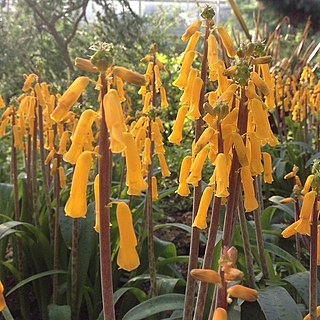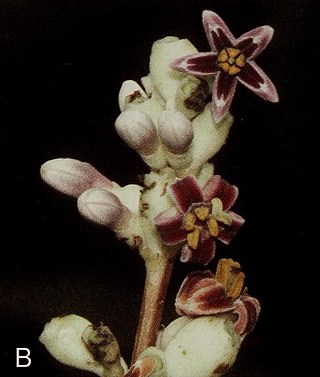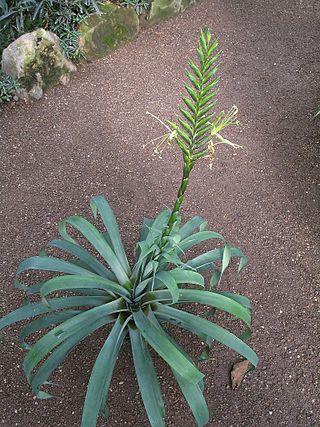
Epipactis, or helleborine, is a genus of terrestrial orchids consisting of approximately 70 species. This genus is abbreviated as Epcts in horticultural trade.

Lachenalia is a genus of bulbous perennial plants in the family Asparagaceae, subfamily Scilloideae, which are usually found in Namibia and South Africa. Most of them have a dormancy period, but new roots will always grow every year.

Hymenostegia is a genus of flowering plants in the family Fabaceae. They are native to Africa.
Lennea viridiflora is a species of legume in the family Fabaceae. Its distribution extends the length of Central America, from the border with Colombia to Mexico. It is found in Costa Rica, El Salvador, Mexico, Nicaragua, and Panama in lowland rainforest. It is threatened by habitat loss.
Aloe viridiflora is a species of plant in the genus Aloe. The species is endemic to Namibia with a wide range and is known from at least six different populations. Current trends are not known and the species is listed as LC on the IUCN Red List. However, it is scarce and Namibian authorities consider it threatened; the plant must not be removed or disturbed. It is the only known green-flowering aloe. Its natural habitats are dry savanna, subtropical or tropical dry shrubland, and rocky areas. It can produce hallucinations when ingested, leading to its occasional use in shamanic rituals.
Ocotea viridiflora is a species of plant, an evergreen tree in the genus Ocotea of the family Lauraceae. It is found in Panama and possibly Costa Rica.
Phaedranassa viridiflora is a species of plant that is endemic to Ecuador. Its natural habitat is subtropical or tropical dry shrubland. It is threatened by habitat loss.
Rustia alba is a species of plant in the family Rubiaceae. It is endemic to Ecuador.

Rustia is a genus of flowering plants in the family Rubiaceae. There are about 14 species distributed in Central and South America. They are shrubs and trees up to 15 metres (49 ft) tall.

Rustia bilsana is a species of plant in the family Rubiaceae. It is endemic to Ecuador.
Tetractomia tetrandra, synonym Terminthodia viridiflora, is a species of plant in the family Rutaceae. It is endemic to Peninsular Malaysia.
Wrightia viridiflora is a species of plant in the family Apocynaceae. It is endemic to Thailand.

Melaleuca viridiflora, commonly known as broad-leaved paperbark, is a plant in the myrtle family Myrtaceae, and is native to woodlands, swamps and streams in monsoonal areas of northern Australia and New Guinea. It is usually a small tree with an open canopy, papery bark and spikes of cream, yellow, green or red flowers.

Pseudalcantarea viridiflora is a species of flowering plant in the family Bromeliaceae, native to Mexico and Central America. It was first described by Johann Georg Beer in 1856.
Cyrtandra viridiflora is a rare species of flowering plant in the African violet family. It is endemic to Hawaii, where it is known only from the northern Koolau Mountains of Oahu. By 2003 there were nine small populations remaining, for a total of 69 plants. It was federally listed as an endangered species in 1996. Like other Hawaiian Cyrtandra it is called ha`iwale.

Ornithogalum viridiflorum, syn. Galtonia viridiflora, the green flowered Galtonia, is a species of bulbous flowering plant from South Africa and Lesotho, grown as an ornamental plant in gardens. It is often sold under its older name Galtonia viridiflora.

Epipactis dunensis, commonly known as dune helleborine, is a species of plant in the orchid family Orchidaceae and is endemic to Great Britain and Ireland. It typically grows to a height of 20–50 cm (7.9–19.7 in) and the upper half of the flowering stalk is hairy. The plant has a long, fleshy rootstock and three to ten yellowish green, oval to lance-shaped leaves arranged in opposite rows along the flowering stem with up to 35 flowers. The three sepals are greenish, the two petals paler, the lower part of the labellum is boat-shaped and dark, chocolate brown with a transparent, whitish rim and the epichile is heart-shaped with a pointed tip. Flowering occurs from late June to mid-August, the flowers are mainly self-pollinated, and the fruit is a capsule, from which light, microscopic seeds are spread by the wind.

Asclepias viridiflora, is commonly known as green comet milkweed, green-flower milkweed, and green milkweed. It is a widely distributed species of milkweed (Asclepias), known from much of the eastern and central United States from Connecticut to Georgia to Arizona to Montana, as well as southern Canada. The Latin specific epithet viridiflora means green-flowered.
Rustia is a genus of cicadas in the family Cicadidae. There are at least two described species in Rustia.










